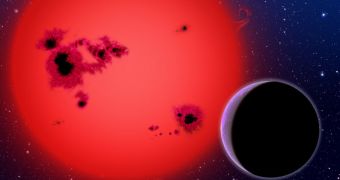Astronomers are excited at the discovery of a Super Earth-class exoplanet very close to our solar system. The celestial body is about 40 light-years away, and it has already revealed clues that it's able to hold an atmosphere around it. Experts also believe that the structure is almost entirely made out of rock and water, and that future telescopes will allow them the ability to observe the exoplanet's atmosphere directly. It was found orbiting a red dwarf star, Space and the National Science Foundation (NSF) report.
The new finding was not made by means of a highly advanced telescope, but through a fleet of smaller observatories, not unlike those many amateur astronomers use. The planet was found to be too hot to support life, but experts using the new array say that the discovery proves once and for all that smaller instruments can be used to detect super-Earth planets – with masses between that of the Earth and Neptune – in life-friendly orbits around other stars. Details of the work are published in the December 17 issue of the respected scientific journal Nature.
The new exoplanet is about 6.5 times the mass of the Earth, the experts announce. The body, dubbed GJ1214b, revolves around its parent star, called GJ1214, in an orbit that takes it too close to the surface to support life. According to preliminary calculations, the planet lies only 1.3 million miles away from the chromosphere. For comparison, the Earth moves around the Sun at a distance of 150 million kilometers. While our planet completes a full swing in roughly 365 days, GJ1214b does one in 38 hours. The host star is about 20 percent the size of our Sun, and astronomers have classified it as a red type M structure.
Because of the proximity between the two bodies, the temperature on the surface of the Super-Earth reaches as much as 400 degrees Fahrenheit (about 200 degrees Celsius). Experts say that the planet is actually very cool, much more so than other transiting planets. The red dwarf it orbits is very dim and only produces three-thousandths as much energy per second as compared to the Sun. The earliest estimates as to the composition of GJ1214b have revealed that the exoplanet is made up of 75 percent water and 25 percent rock.
“Despite its hot temperature, this appears to be a water world. It is much smaller, cooler, and more Earth-like than any other known exoplanet,” Harvard-Smithsonian Center for Astrophysics (CfA) graduate student Zachory Berta says. He is the one who first discovered clues of the planet's existence, among the telescope data. “Since we found the super-earth using a small ground-based telescope, this means that anyone else with a similar telescope and a good CCD camera can detect it too. Students around the world can now study this super-Earth!” MEarth project leader and lead author of this study, Cfa expert David Charbonneau says.

 14 DAY TRIAL //
14 DAY TRIAL // 
